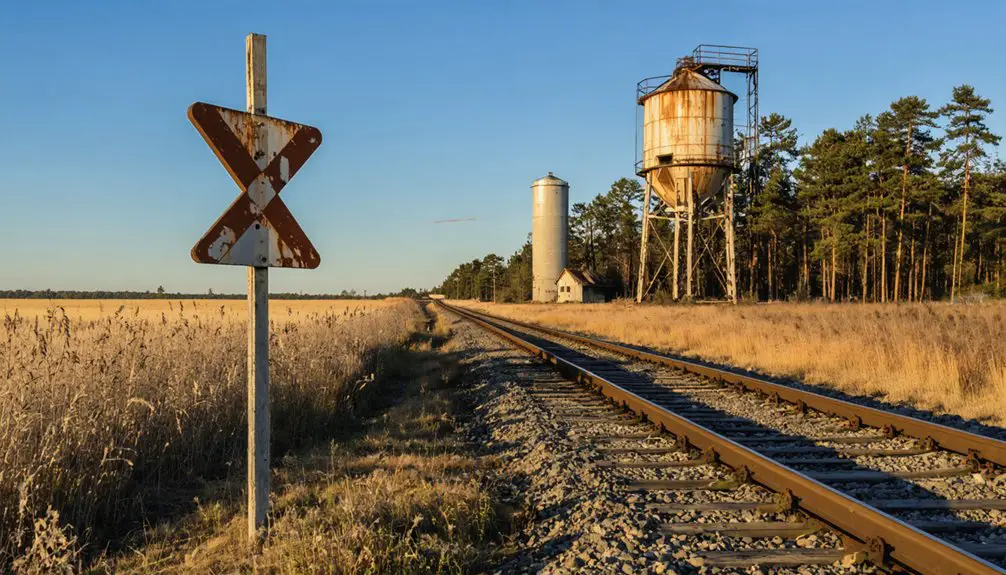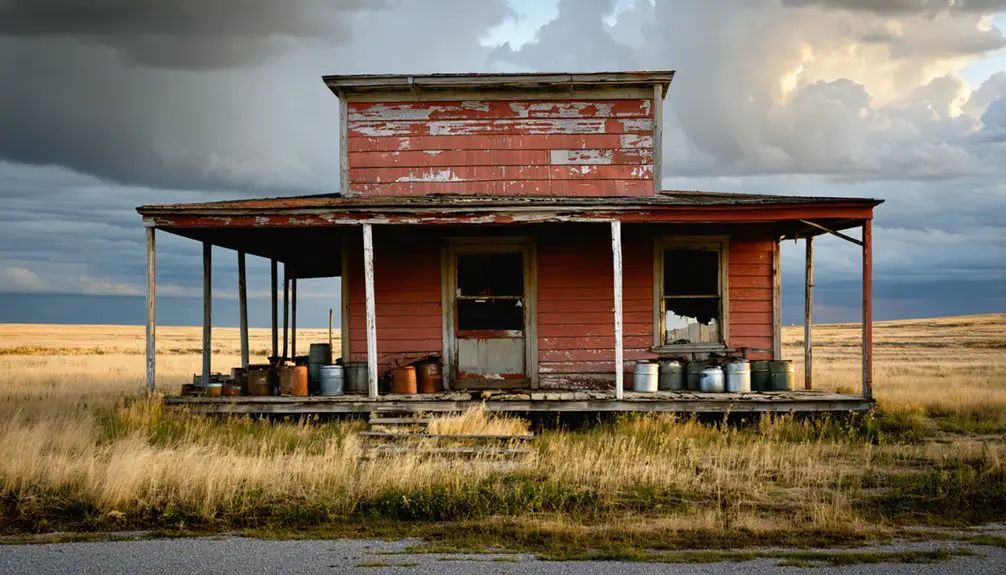You’ll find the ghost town of Pinewood nestled at 1,421 feet in Pine County’s Buzzle Township, Minnesota. Once a bustling logging community in the late 19th century, it thrived on railroad connections and timber extraction. Today, the unincorporated settlement maintains about 147 residents, down from its peak during the resource boom years. Archaeological surveys reveal building foundations, while scattered artifacts and oral histories paint a picture of this former frontier settlement’s rich past.
Key Takeaways
- Pinewood is a ghost town in Pine County, Minnesota, located at 1,421 feet elevation with approximately 147 current residents.
- The town’s decline stemmed from the collapse of logging industries that once thrived on the region’s abundant white pine resources.
- Archaeological evidence includes wooden foundations, building footprints, and period-specific artifacts dating to mid-1800s settlement patterns.
- Transportation infrastructure formerly centered on railroad spurs and wagon roads, with visible remnants of railroad grades still present today.
- Local historical societies work to preserve Pinewood’s history through artifact cataloging and oral history collection from former residents.
Location and Geographic Context
The ghost town of Pinewood sits at an elevation of 1,421 feet in Pine County, Minnesota, positioned at approximately 45.8386°N and 92.9375°W.
You’ll find this abandoned settlement in Buzzle Township, where it holds geographic significance as part of Minnesota’s eighth congressional district.
The site’s topographical features reflect eastern-central Minnesota’s characteristic mixed forest landscape, once dominated by the pine stands that gave the county its name. Several nearby hamlets including Leonard and Aure provide context to Pinewood’s remote location.
You’re in the heart of the Mille Lacs / St. Croix watershed region, where water features make up about 1.6% of Pine County’s 1,411 square miles. The area encompasses 45.8 square miles of land, making it a substantial portion of the county’s territory.
For modern navigation, you can locate Pinewood using its plus code 86V6HVWC+VV, with Pine City serving as the nearest municipal hub and primary access point.
Historical Timeline and Settlement
Four distinct phases marked Pinewood’s historical timeline, beginning with Native American inhabitation by Mdewakanton Sioux tribes who established essential trade routes like the Red River Trail.
During the late 19th century, settlement patterns shifted as European-Americans moved into the area, leading to the town’s founding amid Pine County’s resource extraction boom.
You’ll find that Pinewood’s growth phase coincided with regional industrial development, attracting hundreds of residents through quarrying and railroad operations.
The cultural impact of forced Native American relocations to reservations dramatically altered the area’s demographic makeup.
Local amenities, including post offices, schools, and hotels, flourished during the town’s peak years, supported by railroad connections and industrial employment opportunities.
Like many Minnesota settlements that relied on single industries, the town’s fate mirrored other ghost towns that dot the state’s landscape, eventually succumbing to economic downturns and industry closures that triggered the community’s decline.
Economic Activities and Industries
Building upon its early settlement patterns, Pinewood’s economic foundation rested primarily on resource extraction industries that shaped the region’s development.
You’ll find that logging impacts were significant, as the abundant white pine in northeastern Minnesota drove the local economy. The region’s early sawmills followed the model established when Franklin Steele opened Minnesota’s first private sawmill in 1848. The town’s proximity to waterways made it ideal for transporting logs to market before railroads arrived. Local tribes including the Dakota and Ojibway were key trading partners during the early development period.
Like many Minnesota communities, Pinewood’s fate was tied to the boom-and-bust cycle of natural resources. When mining decline hit nearby operations, such as the Embarrass Mine, it triggered a domino effect throughout the region.
The town’s supporting businesses – general stores, boarding houses, and other services – couldn’t sustain themselves once the primary industries faltered. Rural postal delivery and shifting trade routes further accelerated the community’s economic deterioration.
Remnants and Archaeological Evidence
You’ll find scattered wooden foundations throughout Pinewood’s former townsite, with the most prominent remnants located near where the sawmill and general store once operated.
Archaeological surveys have revealed building footprints of several residential structures and community buildings beneath layers of soil and vegetation. Historical changes from logging activities transformed the surrounding forest landscape significantly. Similar to Old Crow Wing townsite, only traces of the original buildings remain visible today.
The recovery of period-specific artifacts like ceramics, glass fragments, and metal tools helps confirm the town’s mid-1800s occupation patterns and economic activities.
Physical Site Features Identified
Archaeological investigations at Pinewood’s ghost town site have revealed extensive physical evidence of both historic and prehistoric human occupation. Through careful site analysis, researchers have documented multiple cellar depressions, dense clusters of glass bottle fragments, and scattered metal artifacts including nails and projectile points dating to the 18th-19th centuries.
Similar to the 65 post offices that once operated throughout Goodhue County, Pinewood maintained its own postal service facility until its eventual abandonment. Feature interpretation through Ground Penetrating Radar has mapped twenty depression features and revealed buried building walls, palisade remains, and collapsed chimneys.
You’ll find evidence of diverse activities across the landscape, from lithic tool-making areas to zones of domestic life marked by ceramics and smoking pipe fragments. The spatial distribution of these features suggests an organized settlement layout, while paleobotanical analysis indicates the site was primarily used during spring and summer seasons.
Building Foundation Locations
Through extensive field surveys and historical records, researchers have identified numerous building foundation locations across the Pinewood ghost town site.
You’ll find stone rubble lines and partial brick courses marking former cellar walls, while sunken depressions reveal building footprints and foundation types. Historic plat maps and land deeds provide precise coordinates of structures, which align with visible remnants on the ground.
Modern excavation methods have uncovered additional evidence. Ground-penetrating radar detects buried stone foundations and cellars, while shovel test pits expose mortared footings beneath the surface.
Metal detection surveys locate architectural hardware that confirms building positions, and electrical resistivity mapping reveals foundation outlines across yards.
These findings match perfectly with railroad plans and township road plats that oriented Pinewood’s original settlement layout.
Artifact Recovery Areas
Scattered across the former Pinewood settlement, extensive artifact recovery areas reveal the town’s material legacy through a diverse collection of early settler remnants.
You’ll find concentrations of artifacts near former settlement cores and along historical travel routes, where recovery techniques have unearthed metal fragments from farming equipment, ceramic shards, and glass bottle remains.
The artifact significance varies throughout the site, with distinct patterns emerging in different zones.
You’ll discover tool-making debris in peripheral areas and evidence of daily life near former living spaces.
While soil acidity and seasonal freezing affect preservation, the site’s remoteness has helped protect many artifacts.
Through systematic surface surveys and shovel test pits, archaeologists continue mapping these recovery areas, piecing together Pinewood’s story through its material culture.
Population and Demographics
While exact population figures remain elusive, local sources estimate that roughly 147 residents call Pinewood home today. This marks a significant decline from the community’s heyday during the late 19th and early 20th centuries, when the railroad station and timber industry supported a larger population.
You won’t find official demographic breakdowns for Pinewood since it’s classified as an unincorporated community rather than a census-designated place. To understand demographic trends, you’ll need to look at broader Beltrami County statistics.
The area’s population shifts have historically followed the boom-and-bust cycles of resource industries. While Pinewood isn’t officially designated as a ghost town, it represents a common pattern among northern Minnesota’s former rail and timber communities that have experienced substantial population loss. The county’s rapid growth is evident in recent years, with population increasing to 30,197 by 2023 according to estimates.
Transportation Networks

During its prime, Pinewood’s transportation infrastructure centered on an intricate network of railroad spurs, wagon roads, and river access points that supported the town’s logging and milling operations.
The transportation evolution reflected Minnesota’s frontier development, with initial settlement depending on river access before rail connections became crucial. As freight shifts occurred in the early-to-mid 1900s, Pinewood’s accessibility changed dramatically.
- You’ll find remnants of former railroad grades and bridge abutments where timber-hauling spurs once connected to main lines.
- Local wagon roads, originally following indigenous paths, linked the townsite to river landings.
- Seasonal challenges like spring mud and winter snow complicated transportation before road improvements.
- The shift from water and rail to trucking in the mid-1900s bypassed Pinewood, contributing to its decline.
Research Challenges and Documentation
Because official records remain scarce, researching Pinewood’s history presents significant challenges for historians and enthusiasts.
The town’s documentation suffers from significant archival gaps, with limited census data, post office records, and mining company documents available for study. You’ll find that many historical records have been lost or remain locked away in private collections.
Researchers must often rely on oral histories from former residents and their descendants to piece together Pinewood’s past.
Adding to the complexity, the town’s name is frequently confused with similar settlements in the region, making it difficult to verify specific details.
Recent preservation efforts by local historical societies aim to catalog remaining physical evidence and gather firsthand accounts before they’re lost to time.
Frequently Asked Questions
Were There Any Notable Crimes or Tragic Events in Pinewood’s History?
Probing Pinewood’s past reveals you won’t find documented unsolved mysteries or historical accidents. The town’s records don’t show major crimes or tragedies, though regional issues like disease and mining mishaps affected nearby communities.
What Indigenous Tribes Originally Inhabited the Area Before Pinewood’s Establishment?
You’ll find the Ojibwe Tribes were the primary inhabitants, with a centuries-long presence in the region, while the Dakota Nation occasionally traversed the area but mainly lived in southern Minnesota.
Did Any Famous or Notable People Ever Live in Pinewood?
You won’t find any documented famous residents or notable visitors in historical records from Pinewood. Like many small mining settlements of its time, the town’s inhabitants weren’t widely recognized beyond local circles.
What Natural Disasters or Environmental Challenges Affected the Town’s Development?
While you won’t find major disasters in Pinewood’s history, ongoing environmental challenges like mining-related soil degradation, seasonal weather extremes, and resource depletion from logging ultimately shaped the town’s difficult path toward abandonment.
Were There Any Churches, Cemeteries, or Religious Communities in Pinewood?
You won’t find dedicated churches or cemeteries within Pinewood’s boundaries. Church history suggests residents likely attended services in nearby towns, while cemetery significance points to burials in surrounding established graveyards.
References
- https://www.minnesotahistory.org/post/a-complete-guide-to-the-ghost-towns-of-hennepin-county
- https://minnesotasnewcountry.com/want-a-spooky-pine-city-sanatorium-low-price-ghosts-free/
- https://en.wikipedia.org/wiki/Belden
- http://freepages.rootsweb.com/~gtusa/history/usa/mn.htm
- https://en.wikipedia.org/wiki/Chengwatana
- https://mapcarta.com/22429078
- http://wikimapia.org/13645506/Chengwatana-MN-Ghost-Town
- https://en.wikipedia.org/wiki/Pine_County
- https://latitude.to/articles-by-country/us/united-states/168406/pinewood-minnesota
- https://www.youtube.com/watch?v=5bCG6B2rzZY



